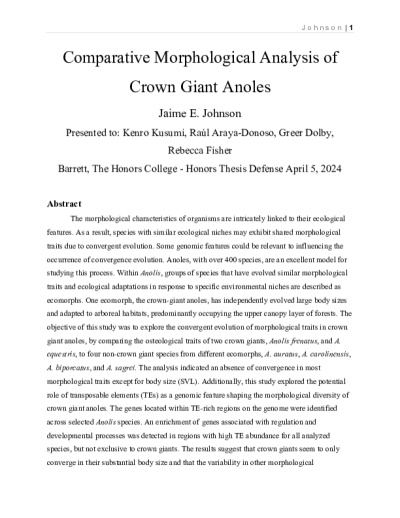Filtering by
- All Subjects: Bioinformatics
- All Subjects: Evolution
- Creators: Kusumi, Kenro




In order to address this, multiple comparative genomics and bioinformatics analyses were conducted to elucidate patterns of evolution in the green anole and across multiple anole species. Comparative genomics analyses were used to infer additional X-linked loci in the green anole, RNAseq data from male and female samples were anayzed to quantify patterns of sex-biased gene expression across the genome, and the extent of dosage compensation on the anole X chromosome was characterized, providing evidence that the sex chromosomes in the green anole are dosage compensated.
In addition, X-linked genes have a lower ratio of nonsynonymous to synonymous substitution rates than the autosomes when compared to other Anolis species, and pairwise rates of evolution in genes across the anole genome were analyzed. To conduct this analysis a new pipeline was created for filtering alignments and performing batch calculations for whole genome coding sequences. This pipeline has been made publicly available.

Agassiz’s desert tortoise (Gopherus agassizii) is a long-lived species native to the Mojave Desert and is listed as threatened under the US Endangered Species Act. To aid conservation efforts for preserving the genetic diversity of this species, we generated a whole genome reference sequence with an annotation based on deep transcriptome sequences of adult skeletal muscle, lung, brain, and blood. The draft genome assembly for G. agassizii has a scaffold N50 length of 252 kbp and a total length of 2.4 Gbp. Genome annotation reveals 20,172 protein-coding genes in the G. agassizii assembly, and that gene structure is more similar to chicken than other turtles. We provide a series of comparative analyses demonstrating (1) that turtles are among the slowest-evolving genome-enabled reptiles, (2) amino acid changes in genes controlling desert tortoise traits such as shell development, longevity and osmoregulation, and (3) fixed variants across the Gopherus species complex in genes related to desert adaptations, including circadian rhythm and innate immune response. This G. agassizii genome reference and annotation is the first such resource for any tortoise, and will serve as a foundation for future analysis of the genetic basis of adaptations to the desert environment, allow for investigation into genomic factors affecting tortoise health, disease and longevity, and serve as a valuable resource for additional studies in this species complex.
Data Availability: All genomic and transcriptomic sequence files are available from the NIH-NCBI BioProject database (accession numbers PRJNA352725, PRJNA352726, and PRJNA281763). All genome assembly, transcriptome assembly, predicted protein, transcript, genome annotation, repeatmasker, phylogenetic trees, .vcf and GO enrichment files are available on Harvard Dataverse (doi:10.7910/DVN/EH2S9K).

